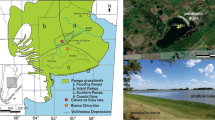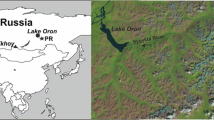Abstract
Some aspects of the paleoproductivity of meromictic Crawford Lake, near Toronto, are inferred from a study of its sedimentary pigments, and diatoms. Several stages of lake development are observed over the 35 cm-deep sediment core removed from the center of Crawford Lake. Evidence of changes in lake productivity during the last 300 years was reflected by significant stratigraphic sediment pigment changes which were associated with European settlement in the Crawford Lake watershed and recent alterations associated with the area's operation by the Conservation Authority (1969 — present). One of the most important factors correlated with paleoproductivity was land clearance (mainly logging of white oak and pine). Deforestation during the last century is correlated with an increase in the amount of algal pigments deposited in the lake's sediments during the 1800's. During the last 10 years a striking increase in the accumulation of chlorophyll derivatives was observed. This is correlated with a dramatic increase in the number of visitors to the lake.
Stratigraphic changes in the ratio of cyanobacterial to phototrophic bacterial pigment accumulation are used to infer changes which occurred during the shift from mesotrophy to eutrophy in Crawford Lake.
Similar content being viewed by others
References
Adams, M. S., P. Guilizzoni & S. Adams, 1978. Sedimentary pigments and recent primary production in northern Italian lakes. Mem. Ist. Ital. Idrobiol. 36: 267–285.
Berglund, B. E., 1979. Palaeohydrological changes in the temperate zone in the last 15 000 years. International Geological Correlation Programme. Lund, Sweden, Project No. 158. 340 pp.
Boyko, M., 1978. European impact of the vegetation around Crawford Lake in Southern Ontario. M. Sc. Thesis, University of Toronto, 110 pp.
Bush, I. C. & L. C. Cwynar. 1972. Crawford Lake research and development project. The Halton Region Conservation Authority, 58 pp.
Dickman, M., 1985. Seasonal succession in microlamina formation in a meromictic lake displying varved sediments. Sedimentology 32: 109–118.
Dickman, M. & M. Dorris, 1977. The impact of human trampling on phosphorus loading to a small lake in Gatineau Park, Quebec, Canada. J. Envir. Mgt. 5: 335–344.
Dickman, M. & P. Hayes, 1982. Meromictic Lakes: Plumbing the stagnant depths. Equinox 3: 121–123.
Engstrom, D. R., E. B. Swain & J. C. Kingston, 1985. A paleolimnological record of human disturbance from Harvey's Lake, Vermont: geochemistry, pigments and diatoms. Freshwat. Biol. 15: 261–288.
Fjerdingstad, E., 1979. Sulfur bacteria. ASTM Special Technical Publication 650: 1–121.
Frey, D. G., 1967. Biological characteristics of meromictic lakes, In Jackson, D. F. (ed). Some aspects of meromixis, Department of Civil Engineering, Syracuse University: 65–95.
Goodwin, E., 1965. Distribution of carotenoids, In T.W. Goodwin (ed), Chemistry and Biochemistry of plant pigments. Academic Press: 143–173.
Gorham, E., 1960. The chlorophyll derivatives in surface muds from the English Lakes. Limnol. Oceanogr. 5: 29–33.
Gorham, E., 1961. Chlorophyll derivatives, sulphur and carbon in sediments cores from two English Lakes. Can. J. Bot. 39: 333–338.
Gorham, E., J. W. G. Lund, J. E. Sanger & W. E. Dean, 1974. Some relationship between algal standing crop, water chemistry and sediment chemistry in the English Lakes. Limnol. Oceanogr. 19: 601–617.
Griffiths, M., P. S. Perrot & W. T. Edmondson, 1968. Oscillaxanthin in the sediment of Lake Washington. Limnol. Oceanogr. 20: 945–952.
Guilizzoni, P., G. Bononi, G. Galanti & D. Ruggiu, 1983. Relationship between sedimentary pigments and primary production: evidence from core analyses of twelve Italian lakes. Hydrobiologia 103: 103–106.
Hertzberg, S., S. Liaaen-Jensen & H. W. Siegelman, 1971. The carotenoids of blue-green algae. Phytochemistry 10: 79–87.
Hutchinson, G. E., 1956. A treatise on Limnology Vol. I. Wiley & Sons, New York.
McAndrews, J. H., 1972. Tour Guide of Crawford Lake. A Royal Ontario Museum Publication.
Parkin, T. B. & T. D. Brock, 1981. Photosynthetic bacterial production and carbon mineralization in a meromictic lake. Arch. Hydrobiol. 91: 366–382.
Rowe, J. S., 1959. Forest regions of Canada. Dept. Northern Affairs, Natural Resources, Forestry Branch Bull. No. 123.
Rybak, I. & M. Rybak, 1985a. Development of Lake Kortowskie in relation to the climatic changes in three Holocene periods. Hydrobiologia 124: 151–166.
Rybak, I. & M. Rybak, 1985b. Stratigraphy of fossil pigments as a guide to the environmental changes of Kortowskie Lake. Acta Hydrochim. Hydrobiol. 13: 297–305.
Rybak, M., 1985. Some ecological effects of artificial destratification on phytoplankton. Hydrobiologia 122: 89–96.
Rybak, M., 1986. Chlorobium chlorophyll as an indicator of pollution in paleolimnological investigation. Acta Hydrochim. Hydrobiol. 14: 255–261.
Rybak, M., 1987. The effect of agriculture on the primary production in the lake recorded by the stratigraphy of fossil pigments. Hydrobiologia (in press).
Rybak, M. & I. Rybak, 1982. Plant pigments in contemporary bottom sediments of Lake Dlugie in Olsztyn. Acta Hydrobiol. 24: 21–28.
Rybak, M., I. Rybak & M. Zadrozna, 1987a. Paleolimnology of a small oligotrophic lake in Wolin Island, Baltic Sea, Poland. Hydrobiologia 146: 169–179.
Rybak, M., I. Rybak & M. Dickman, 1987b. Fossil chrysophycean cyst flora in a small meromictic lake in Southern Ontario, and its paleoecological interpretation. Can. J. Bot. 69: 2425–2440.
Sanger, J. E. & G. H. Crowl, 1979. Fossil pigments as a guide the paleolimnology of Browns Lake, Ohio. Quat. Res. 11: 342–352.
Sanger, J. E. & E. Gorham, 1970. The diversity of pigments in lake sediments and its ecological significance. Limnol. Oceanogr. 15: 59–69.
Sanger, J. E. & E. Gorham, 1972. Stratigraphy of fossil pigments as a guide to the postglacial history of Kirchner Marsh, Minnesota. Limnol. Oceanogr. 17: 840–854.
Severn, S., 1981. Factors influencing the seasonal changes in primary productivity of the photosynthetic bacteria of Crawford Lake, Ontario. M. Sc. Thesis, Brock University, St. Catharines, Ontario L2S 3A1.
Stoermer, E. F., B. G. Ladewski & G. L. Schelske, 1978. Population response of Lake Michigan phytoplankton to nitrogen and phosphorus enrichment. Hydrobiologia 57: 249–265.
Swain, E. B., 1985. Measurement and interpretation of sedimentary pigments. Freshwat. Biol. 15: 53–75.
Wundsch, H. H., 1940. Beitrage zur Fixhereibioologie markischer Seekn. VI. Die Entwicklung eines besonderseren Seetypus (H2S-Oscillatorien-Skeen) in Fluss-Seengebiet der Spree und Havel, une seine. Bedeutung fur die fishereibiologischen Bedingungen in dieser Region. Ztschr. f. Fisch. 38: 443–658.
Zulling, H., 1985. Carotenoids from plankton and phototrophic bacteria in sediments as indicators of trophic changes: evidence from the Late-glacial and early Holocene of Lobsigensee: 143–147 in Lange, G. (ed) Swiss lake and mire environments during the last 15 000 years. J. Cramer, F1–9490 Vaduz.
Author information
Authors and Affiliations
Rights and permissions
About this article
Cite this article
Rybak, M., Dickman, M. Paleoecological reconstruction of changes in the productivity of a small, meromictic lake in Southern Ontario, Canada. Hydrobiologia 169, 293–306 (1988). https://doi.org/10.1007/BF00007552
Received:
Revised:
Accepted:
Issue Date:
DOI: https://doi.org/10.1007/BF00007552




